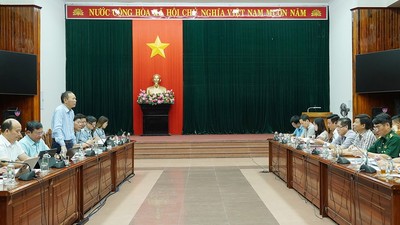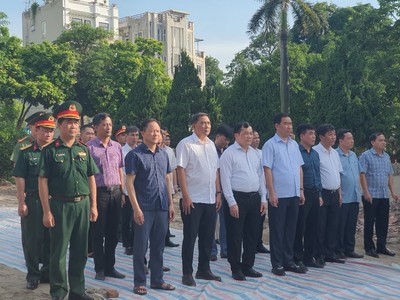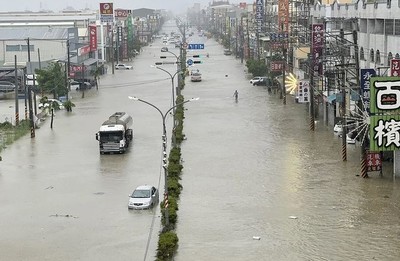Công bố quốc tế lĩnh vực môi trường số 06-2024
Ban biên tập Chuyên trang Quản lý Môi trường, Tạp chí Môi trường và Đô thị Việt Nam trân trọng giới thiệu tới quý độc giả Công bố quốc tế lĩnh vực môi trường số 06-2024.
Về quản lý môi trường
- Phân tích phản ứng nguồn-chìm của kim loại nặng và đánh giá ô nhiễm đất tại các khu vực tập trung công nghiệp kim loại màu dựa trên đơn vị quyết định.
- Phân tích ô nhiễm không khí ở Tây Bắc Nam Mỹ: Khung Lagrange mới.
- Khám phá lộ trình xử lý nước thải sinh hoạt bền vững ở nông thôn-từ góc độ đánh giá vòng đời.
- Chiến lược thúc đẩy năng lượng tái tạo để sản xuất sạch hơn ở các nền kinh tế G7: Thông qua tiến bộ kinh tế và thể chế.
- Tác động của kết nối từ xa trên đất xây dựng đối với gánh nặng carbon trong khu vực theo lộ trình kinh tế xã hội chung.
- Sự gia tăng bất thường của amoniac trong khí quyển toàn cầu trong thời gian phong tỏa vì dịch COVID-19: Cần có chính sách hạn chế khí thải nông nghiệp.
- Tác động của những thay đổi về khí hậu, sử dụng đất và khí thải đối với chất lượng không khí ozone toàn cầu vào giữa thế kỷ 21 theo các Lộ trình Kinh tế Xã hội Chung đã chọn.
- Sự lan tỏa năng động giữa thị trường carbon, chứng khoán và năng lượng: Trường hợp của New Zealand.
- Hình dung các phương pháp tiếp cận sáng tạo để đạt được nền kinh tế tuần hoàn trong lĩnh vực nước và nước thải.
- Xanh hóa vành đai và con đường: GVC cách mạng hóa cường độ carbon ở các quốc gia tham gia như thế nào?
Về môi trường đô thị
- Tổng hợp cordierite sử dụng tro bay từ quá trình đốt chất rắn đô thị làm phụ gia để tăng cường quá trình oxy hóa xúc tác chất hữu cơ cơ dễ bay hơi.
- Phân tích tác động và dự báo xác thực (EAPF) của quản lý thời gian thực đối với ngập đô thị: Khung xác minh hai chiều mới.
- Sự tương phản về không gian và những thay đổi theo thời gian ở mức độ dễ thương tổn và phơi nhiễm nhiệt độ ở quy mô nhỏ ở khu vực Paris.
- Sự dậy dậy và hạ bệ của ốc đảo gia cầm: Theo dõi tác động của việc thay đổi cách sử dụng đất ở vùng đất ngập nước ven biển quan ở siêu đô thị lớn nhất thế giới.
- Mô hình ô nhiễm đô thị không gian và thời gian dựa trên chế độ cơ sở dữ liệu của các trạm khảo sát.
- Hạt nhựa có mặt khắp nơi và ngày càng tăng trong đất của khu đô thị rộng lớn ở Phoenix (Arizona).
- Chất lượng ảnh hưởng đến đô thị như thế nào đến giá trị đất: Khám phá cơ chế ngưỡng và phi tuyến tính bằng trí tuệ nhân tạo có thể giải quyết được.
- Giám sát lá từ sinh học có còn là phương pháp hiệu quả để giám sát tình trạng ô nhiễm kim loại nặng của các hạt vật chất trong khí quyển ở các thành phố sạch không?
- Không có giai đoạn đô thị xanh xác định các cộng đồng sinh vật đất theo cách thức cụ thể của từng địa điểm.
- Mô phỏng kịch bản và phân tích sản phẩm tổng hợp CO2 và việc giảm phát chất ô nhiễm bụi khí trong lĩnh vực giao thông đô thị: Nghiên cứu trường hợp ở Thành Đô, Trung Quốc.
Về môi trường khu công nghiệp
- Các chiến lược dự đoán hiệu quả phát thải carbon công nghiệp và giảm phát thải carbon dựa trên phương pháp truyền ngược tối ưu hóa bầy hạt đa mục tiêu: Một góc nhìn từ việc phân cụm khu vực.
- Tác động của môi trường an toàn đến sự tương tác giữa con người và công nghệ và sự phát triển bền vững: Bằng chứng từ ngành dầu khí Indonesia.
- Phân phối và vận chuyển các chất gây ô nhiễm trong đất thông qua các quá trình khai thác mỏ cũng như đánh giá tác động môi trường và nguy cơ sức khỏe của nó: Đánh giá các giải pháp tiềm năng.
- Hydrocacbon thơm đa vòng (PAH) trong sản phẩm nhà máy tuyển than: Tác nhân gây ô nhiễm môi trường.
- Hiểu biết sâu sắc về các quá trình sinh học hiện tại và triển vọng trong tương lai về xử lý trung hòa carbon đối với nước thải hữu cơ công nghiệp: Đánh giá quan trọng.
- Một cách tiếp cận để đo lường và phân tích lượng carbon tiêu thụ trong chuỗi ngành xây dựng dựa trên tính toán các chất gây ô nhiễm.
- Nhà máy tinh chế chất thải sinh học từ bùn thải công nghiệp giấy bột giấy để phát triển năng lượng bền vững và các sản phẩm có giá trị gia tăng: Định giá một cách có hệ thống hướng tới quản lý chất thải.
- Tái định hướng phát thải carbon thấp trong một ngành đang suy thoái: Phân tích bối cảnh về việc thay đổi chiến lược của các công ty trong lĩnh vực lọc dầu ở Vương quốc Anh (1990–2023).
- Tưởng tượng về carbon tuần hoàn: Chiến lược giảm thiểu (răn đe) cho ngành hóa dầu.
- Khử cacbon trong ngành xử lý bùn: Đánh giá tính khả thi của việc đạt được mức giảm cacbon từ đỉnh cacbon đến trung hòa cacbon.
- Tác động của chính sách quỹ chính phủ và công nghệ blockchain đến chuỗi cung ứng khép kín trong ngành dệt may.
Xin trân trọng giới thiệu!
QUẢN LÝ MÔI TRƯỜNG
1. Source-sink response analysis of heavy metals and soil pollution assessment in non-ferrous metal industrial agglomeration areas based on decision unit
Science of The Total Environment, Volume 906, 1 January 2024, 167437
Abstract
Soil heavy metals (HMs) pollution is a worldwide concern. In this study, decision units based on "source-sink relationship” were established using multi-source data. The source-sink response of heavy metals in agricultural soils at the regional scale was analyzed using machine learning methods, receptor models, and geospatial analysis. The comprehensive pollution risk score (CRS) was proposed by integrating a variety of key evaluation indicators to evaluate the pollution degree of each decision unit. We divided the study area into 193 decision units, the proportions of sites with concentrations of Cd, Hg, As, Pb, and Cr exceeding the most stringent risk screening values were 16.4 %, 2.2 %, 4.0 %, 7.6 %, and 0.2 %, respectively.
Agricultural activities (livestock manure, fertilizer, sewage irrigation), industrial activities (rare earth ore and tungsten‑molybdenum mining and smelting), and soil parent material are the dominant pollution sources of HMs in the study area. The risk of contamination of each element is ranked from largest to smallest according to the CRS as Cd > Hg > Pb > As > Cr. The western and southwestern water pollution decision units are the areas with the highest risk of soil HMs contamination. This quantitative evaluation framework can provide a relatively accurate decision basis for soil pollution management.
2. The impact of carbon tax policy on residents’ welfare of China and its heterogeneity under the carbon neutrality goal: A CGE model-based analysis
Journal of Cleaner Production, Volume 434, 1 January 2024, 140442
Abstract
Under the background that China will achieve the goal of carbon neutrality by 2060, analyzing the impact of carbon neutral target constraints on the welfare of urban and rural residents is an important part of the design of a carbon emission reduction policy mechanism, in this paper, the dynamic recursive CGE(Computable general equilibrium) model is used to simulate the changes in welfare level, income consumption, and CO2 emissions of residents and their urban-rural heterogeneity under the policy of imposing a carbon tax on the fossil energy industry from 2022 to 2060.
The results show that: compared with the BAU scenario, by 2060, first the income and consumption of residents will decrease slightly. Second, the target constraint of carbon neutrality makes the equivalent variation and compensate variation of urban and rural residents' welfare decrease slightly, and the equivalent variation and compensate variation of urban residents decrease more than those of rural residents. The following conclusions are drawn: first, the carbon-neutral target constraint makes the welfare of urban and rural residents decline slightly, but it will not have a strong impact on residents’ income and consumption. Second, this constraint has a greater impact on the income, consumption and savings of urban residents than those of rural residents.
3. Air pollution analysis in Northwestern South America: A new Lagrangian framework
Science of The Total Environment, Volume 906, 1 January 2024, 167350
Abstract
This study examines the spatiotemporal variations of PM2.5, PM10, SO2, O3, NO, and NO2 concentrations in Northwestern South America (NWSA). We assess the efficacy of existing policies, identify underlying phenomena, and highlight areas for further research. Significant findings have emerged by analyzing reanalysis and in-situ data, employing the WRF-Chem model, and utilizing a new Lagrangian framework designed to overcome some drawbacks common to analysis of pollution Long-Range Transport. Wildfires in the first half of the year and volcanic activity (for SO2) in July–August contribute to over 90 % of the pollutant's advection, leading to high pollution levels in urban areas. SO2 volcanic emissions contribute to secondary PM, explaining the peak in PM concentrations in Cali in July. In the second half of the year, pollutant behavior varies based on factors such as city characteristics, vehicular-volume, air temperature, wind speed, and boundary layer height, and O3 is influenced by solar radiation and the NO/NO2 ratio.
Diurnal variations of PM and NOx correlate with vehicular density, SO2 with industrial activity, and O3 depends on solar radiation. Trend analysis reveals decreasing PM10 levels except in three Cundinamarca cities and Cali suggesting the need to implement/evaluate control plans in those locations. Although data is limited, NO and NO2 levels show an increasing trend due to the rising number of vehicles. SO2 levels are decreasing, except in Cali, potentially influenced by the nearby industrial and polluted city of Yumbo. O3 displays a downward trend in most cities, except Bogotá, due to the NO/NO2 ratio favoring O3 increase. These findings provide a starting point for further research to deepen our understanding of NWSA air pollution. Such investigations are essential before modifying existing policies or enacting new ones. Collaborative efforts at the international, regional, and inter-city levels are crucial for effective air quality management.
4. Exploration of sustainable driving path of rural domestic wastewater treatment-from the perspective of life cycle assessment
Journal of Cleaner Production, Volume 434, 1 January 2024, 140403
Abstract
Most rural wastewater treatment facilities require electricity to maintain operation. Traditional fossil energy consumption increases the environmental load and greenhouse gas emissions. Wind-solar power generation is widely recognized as a renewable energy technology. However, conventional wind-solar power systems need batteries to store energy, which can lead to secondary pollution. Additionally, the alternating aerobic and anaerobic process were crucial for nitrogen and phosphorus removal, and some distributed wastewater treatment systems do not require continuity operation.
Therefore, this study reports on a wind–solar power generation mode without batteries (Mode-II) to control and drive a bioecological rural domestic wastewater treatment system with a scale of 0.5 m³/day. By logic control, the inspired combination of power generation capacity and treatment process requirements was realized. The effluent CODcr, NH4+-N, and TN concentrations were 14.63 ± 7.02, 1.39 ± 1.63, and 8.65 ± 4.02 mg/L, with removal rates of 89.01 ± 4.15%, 88.58 ± 2.28%, 75.47 ± 8.84%, respectively. From the perspective of environmental load and carbon emissions, based on life cycle assessment theory, this novel approach was compared with the traditional wind–solar power generation driven mode with battery storage (Mode-I) and mains power driven mode (Mode-III). The environmental load and carbon emissions of Mode-II were 1.08 kPt and 2836 kg CO2 eq by end-of-life (25 years), the lowest of the three modes. Compared with the mains power drive mode, the environmental load and carbon emissions of Mode-II can be repayment until years 6 and 2. The supercapacitors and solar panels were the main source of environmental load and carbon emissions for Mode-II. Overall, Mode-II was found to be the most environmentally friendly mode all over the China, which is expected to be promoted in the field of rural wastewater treatment.
5. Assessing the evolution and attribution of watershed resilience in arid inland river basins, Northwest China
Science of The Total Environment, Volume 906, 1 January 2024, 167534
Abstract
Water scarcity significantly limits the sustainable development of oasis economies in arid inland river basins. Quantifying watershed resilience and its drivers is a major focus in the fields of hydrology and water resources. In this study, the resilience indicator represents watershed resilience, while meteorological, hydrological, socioeconomic, and ecological factors are used to investigate the spatial and temporal patterns of resilience and important driving factors in the Hotan River Basin from 1958 to 2020 by combining principal component analysis and random forest model. Results show that the overall resilience of the Hotan River Basin is low, decreasing from the upper (upstream) to the middle and lower (downstream) reaches, and that the intensity of human activities has a negative impact on resilience. Rivers are more likely to reach maximum resilience after experiencing periods of wet and dry conditions, although there is a lag in this progress.
The random forest machine learning algorithm was used to accurately predict the resilience levels of the two upstream tributaries Yurungkash and Karakash Rivers, and the downstream Hotan River, with classification accuracies of 84.2 %, 71.4 %, and 87 %, respectively. The factors affecting the resilience of the Yurungkash River are the 30-day maximum, base flow index, low pulse duration, median streamflow in May, median streamflow in August, median streamflow in October, and 7-day maximum. The set of factors used to classify the resilience of the Karakash River include the 7-day maximum, 1-day maximum, median streamflow in June, 30-day maximum, 3-day maximum, median streamflow in February, and autumn temperature. The factors affecting the resilience of the Hotan River are the watershed inflow, Xiaota station runoff, population growth rate, and effective irrigated area. The findings of this study provide a theoretical basis for integrated water resource management and the sustainable development of the oasis economy in the Hotan River Basin.
6. A strategy for the promotion of renewable energy for cleaner production in G7 economies: By means of economic and institutional progress
Journal of Cleaner Production, Volume 434, 1 January 2024, 140323
Abstract
Based on the experience of G-7 economies, the present study provides a strategy for other developed and developing nations to expedite the transition process from nonrenewable to clean renewable energy for cleaner production. To establish an empirical framework, data of G-7 democracies considered from 1995 to 2020 and employed the Augmented Mean Group model to expose the short-run and long-run influence of institutional quality and quality of democracy to switch from nonrenewable to renewable energy trajectory.
The pace of transition is measured in terms of the ratio of renewable energy in the total energy mix, and a higher ratio indicates a greater share of renewable energy in total energy produced from different nonrenewable sources such as Oil, coal, and gas. The findings indicate that institutional quality and strong democratic governments are more active in developing renewable energy infrastructure as compared to governments operating with weak institutions and poor quality of democracy. The coefficient of the Institutional quality variable is greater than the variable of democracy quality, these findings infer that strong institutions are an inevitable and crucial factor in making a swift transition from nonrenewable to renewable energy production in G-7 democracies.
7. The impact of teleconnections of built-up land on regional carbon burden under the shared socio-economic pathways
Science of The Total Environment, Volume 906, 1 January 2024, 167589
Abstract
The expansion of built-up land is currently being increasingly triggered by remote demand, thus disturbing the local process of carbon neutrality significantly. It is meaningful to understand the relations between regional development and carbon balance. To this end, we combine the multi-regional input-output model with the land system cellular automata model for potential effects (LANDSCAPE) to illustrate the impact that regional development has on the carbon burden.
The results show that the expansion of built-up land results in a regional carbon burden through taking over ecological land and generating carbon emissions, to which the manufacturing industry land is the largest contributor. Regionally, developed regions exert the greatest influences on the changes in the regional carbon burden, mainly because the promotion of their development leads to the expansion of built-up land in all regions. Developing regions can impact undeveloped regions and themselves, while it is hard for undeveloped regions to change the regional carbon burden due to their low capacity to externally drive the expansion of built-up land. Meanwhile, the continuing development of developed regions exerts great pressure on carbon neutrality in both developing and undeveloped regions as they expand the "high-quality” built-up land themselves, which means that regional development may lead to changes in the carbon burden of regions which are less developed.
8. Anomalous increase in global atmospheric ammonia during COVID-19 lockdown: Need policies to curb agricultural emissions
Journal of Cleaner Production, Volume 434, 1 January 2024, 140424
Abstract
The restrictions imposed on human activities during the COVID-19 lockdown (LD) period provided a new scenario to identify potential sources of atmospheric pollution. There are several studies that deal with changes in air quality around the world during LD, but very few on atmospheric ammonia (NH3). Therefore, we examine the changes in global NH3 during LD (April–May 2020) in comparison to the pre-lockdown (PreLD, April–May 2017–2019) and post-lockdown (PostLD, April–May 2021) periods, and assess the factors responsible for these changes. We observe an increase in NH3 during LD across the latitudes, with very high values in the western Europe, Eastern China (EC), the Indian subcontinent and the eastern United States of America (USA). However, a decline in NH3 is observed in some regions of South America (SA) and North America (NA). Similar changes in NH3 during LD are also observed in smaller spatial scales, as found in 3000 cities across the globe. The reduction of sulphur dioxide (SO2), nitrogen dioxide (NO2), nitric acid (HNO3), humidity and cloud cover as a result of restrictions on human activities, particularly in the western Europe and the USA, may have impeded the conversion of NH3 to particulates, which led to a higher NH3 there.
Nevertheless, agricultural activities and livestock are the most prominent sources of atmospheric NH3, and were not under restriction during LD, show an enhancement in terms of the use of nitrogen fertilizer, crop production and area harvested, which also cause a rise in NH3 in these regions. Therefore, it is evident that the changes in meteorology and atmospheric composition, together with increased agricultural activities, led to the global increase in atmospheric NH3 during LD. That is, most pollutants show a decline during LD, but NH3 exhibits a rise due to its sources such as agricultural activities. Henceforth, environmental regulations, policies and advanced technologies are required in the agricultural sector, such as fertilizer deep placement using urea briquettes and restricted application of nitrogen fertilizers, to curb NH3 emissions.
9. Differential responses of crop yields to multi-timescale drought in mainland China: Spatiotemporal patterns and climate drivers
Science of The Total Environment, Volume 906, 1 January 2024, 167559
Abstract
Increasingly frequent and severe droughts pose a growing threat to food security in China. However, our understanding of how different crops respond to multi-timescale drought under varying climatic conditions remains limited, hindering effective drought risk management. To address this knowledge gap, we applied spatial principal component analysis (SPCA) to unveil spatiotemporal patterns in annual yields of major grain crops (rice, wheat, maize) and cotton in response to multi-timescale drought, as indicated by the standardized precipitation evapotranspiration index (SPEI) across China. Subsequently, predictive discriminant analysis (PDA) was employed to identify the primary climatic factors driving these response patterns. The findings indicated that drought-induced interannual variability of crop yields were spatially and temporally heterogeneous, closely tied to the timescale used for drought assessment.
Crop types displayed distinct responses to drought, evident in the variations of months and corresponding timescales for their strongest reactions. The initial three principal components, capturing over 65 % of drought-related yield variance, unveiled short- to medium-term patterns for rice, maize, and cotton, and long-term patterns for wheat. Specifically, rice was highly susceptible to drought on a 4-month timescale in September, wheat on a 6-month timescale in May, maize on a 3-month timescale in August, and cotton on a 3-month timescale in September. Moreover, the first three discriminant functions explaining over 90 % of the total variance, effectively distinguish spatiotemporal crop yield response patterns to drought. These patterns primarily stem from seasonal climatic averages, with water balance (precipitation minus potential evapotranspiration) and temperature being the most influential variables (p < 0.05). Interestingly, we observed a weak correlation between drought severity and crop yield in humid conditions, with responses tending to manifest over longer timescales. These findings enhance our comprehension of how drought timescales impact crop yields in China, providing valuable insights for the implementation of rational irrigation management strategies.
10. The influence of the guidance on building a green financial system on environmentally friendly firms’ total factor productivity in China
Journal of Cleaner Production, Volume 434, 1 January 2024, 140516
Abstract
With China's proposed green development strategy, environmental protection investment needs are growing exponentially, and government funding alone is inadequate to meet the massive demand. To encourage social investment in green industries and achieve green development goals, the authorities implemented the major green finance policy entitled the Guidance on Building a Green Financial System (GBGFS) in late 2016. Whether this policy effectively promotes the development of environmentally friendly (EF) firms is an essential under investigated question. This study employs a difference-in-differences approach to explore whether and how the GBGFS affects EF firms' total factor productivity (TFP) with a sample from 2012 to 2021.
Our benchmark regression and robustness tests demonstrate that the GBGFS effectively promotes EF firms' TFP. We also obtain three notable research findings with a number of additional analyses. (a) Although there is a certain lag, the policy effect was obviously enhanced with the passage of time. (b) Our threshold effect analyses reveal that the enhancing effect of the GBGFS on EF firms' TFP only becomes significant when research and development (R&D) investment, profitability (ROA), and government subsidies (GSF) exceed certain values. Further analysis demonstrates that firms with higher ROA and more GSF can effectively increase R&D. (c) Finally, GBGFS implementation has a greater impact on firm TFP in China's more developed region than its less developed regions. The findings suggest that regulatory authorities should persist in enforcing the GBGFS policy and encourage corporate R&D investment. In addition, the central government should design targeted policies based on the characteristics of different regions to improve the policy effect.
11. Impacts of changes in climate, land use, and emissions on global ozone air quality by mid-21st century following selected Shared Socioeconomic Pathways
Science of The Total Environment, Volume 906, 1 January 2024, 167759
Abstract
Surface ozone (O3) is a major air pollutant and greenhouse gas with significant risks to human health, vegetation, and climate. Uncertainties around the impacts of various critical factors on O3 is crucial to understand. We used the Community Earth System Model to investigate the impacts of land use and land cover change (LULCC), climate, and emissions on global O3 air quality under selected Shared Socioeconomic Pathways (SSPs). Our findings show that increasing forest cover by 20 % under SSP1 in East China, Europe, and the eastern US leads to higher isoprene emissions leading 2–5 ppb increase in summer O3 levels. Climate-induced meteorological changes, like rising temperatures, further enhance BVOC emissions and increase O3 levels by 10–20 ppb in urban areas with high NOx levels.
However, higher BVOC emissions can reduce O3 levels by 5–10 ppb in remote environments. Future NOx emissions control reduces O3 levels by 5–20 ppb in the US and Europe in all SSPs, but reductions in NOx and changes in oxidant titration increase O3 in southeast China in SSP5. Increased NOx emissions in southern Africa and India significantly elevate O3 levels up to 15 ppb under different SSPs. Climate change is equally important as emissions changes, sometimes countering the benefits of emissions control. The combined effects of emissions, climate, and land cover result in worse O3 air quality in northern India (+40 %) and East China (+20 %) under SSP3 due to anthropogenic NOx and climate-induced BVOC emissions. Over the northern hemisphere, surface O3 decreases due to reduced NOx emissions, although climate and land use changes can increase O3 levels regionally. By 2050, O3 levels in most Asian regions exceed the World Health Organization safety limit for over 150 days per year. Our study emphasizes the need to consider complex interactions for effective air pollution control and management in the future.
12. Dynamic spillovers between the carbon, stock, and energy markets: A New Zealand case
Journal of Cleaner Production, Volume 434, 1 January 2024, 140278
Abstract
The Emission Trading Scheme (ETS) is an essential instrument tightly interconnected with the stock and energy markets. This study innovatively incorporates the ETS, stock, and energy markets into an integrated framework to model the return and volatility spillovers. We utilize a dynamic Time-Varying AutoRegressive procedure grounded in both the temporal and frequency domains. Our findings certify time-varying effects in both return and volatility spillovers. Remarkably, extreme events such as the COVID-19 pandemic and New Zealand's ETS-led policies have contributed substantially to these spillovers. Specifically, for return spillovers, the price movements of the stock and the crude oil markets are distinctly influenced by the ETS and electricity markets. On the other hand, volatility spillovers in stock and energy markets are predominantly dominated by the ETS. Furthermore, return and volatility spillovers exhibit substantial heterogeneity across different frequencies, with long-term effects making up the most considerable portion of cross-market spillovers. These findings help gain a deeper understanding of dynamic feedback effects and offer valuable implications for policymakers and market participants.
13. Agricultural tridimension pollution emission efficiency in China: An evaluation system and influencing factors
Science of The Total Environment, Volume 906, 1 January 2024, 167782
Abstract
We innovated traditional one-sided agricultural carbon emission efficiency research, comprehensively explored the agricultural tridimension pollution emission efficiency (ATPEE), constructed an ATPEE evaluation system considering technological heterogeneity characteristics based on the meta-frontier nonradial directional distance function (NDDF) model in a total-factor framework, evaluated the ATPEE in 30 mainland China provinces from 1997 to 2021 for the first time, and empirically studied the factors influencing the ATPEE in China with the Tobit model.
The results showed the following: (1) ATPEE improvement potentials of 75.16 % and 50.88 % occur under the meta and group frontiers, respectively. (2) The eastern region represents the potential optimal agricultural tridimension pollution emission technology, while the central and western regions exhibit a large gap with the national potential optimal technology level. (3) The ATPEE loss in the eastern and western regions mainly results from management inefficiency, while that in the central region largely results from technology gap inefficiency. (4) The effects of the industrialization rate, urban–rural income gap, agricultural production structure, financial support for agriculture, natural conditions and effective irrigation rate on the ATPEE in the different regions vary.
14. Power transitions and pollution reduction: Decoding the impact of municipal leadership changes on firm-level pollution in China
Journal of Cleaner Production, Volume 434, 1 January 2024, 140337
Abstract
This research examines the influence of political system changes, particularly official turnover, on pollution reduction in Chinese industrial firms—a response to the environmental challenges posed by China's economic growth. Utilizing micro-panel data from 2000 to 2014 and an official turnover database, this study assesses how these turnovers affect firm-level pollution. The analysis confirms that official turnovers significantly reduce emissions, with the effect more pronounced in non-state-owned enterprises, under officials who are male, hold PhDs, and are older.
This impact is also stronger in areas with a larger tertiary sectors and higher economic growth. A detailed comparison reveals that mayoral turnovers have a greater abatement effect than those of municipal secretaries, especially in cases of abnormal turnovers. Crucially, this study demonstrates that mayoral turnovers lead to pollution reduction by promoting corporate exports and innovation. The baseline regression results, confirmed as robust after extensive robustness checks, underscore the significance of these findings. This paper sheds light on the political dynamics of environmental governance in China, advocating bureaucratic reforms to reduce emissions and providing strategic recommendations to improve national environmental sustainability.
15. Envisioning the innovative approaches to achieve circular economy in the water and wastewater sector
Environmental Research, Volume 241, 15 January 2024, 117663
Abstract
Given the challenges of urbanization and rapid resource depletion, policymakers have been compelled to abandon the old sequential paradigm of "take-make-use-dispose” to a circular approach that prioritizes preservation of natural resources. The circular economy represents a sustainable management concept that focuses on reducing, recovering, reusing, and recycling waste. While significant strides have been made in implementing circular economy principles in various industries such as automotive, electronics, and construction, particular attention has been given to the water and wastewater domains due to imbalances in water resources.
Here we review the global progress of circular economy adoptability in the water and wastewater domains, considering technical, environmental, economic, and social perspectives. It assesses the current state of circular economy integration in the wastewater domain worldwide and presents approaches to promote and accelerate its adoption. The study critically examines the principles of waste management, known as the 6Rs (reclaim, restore, recycle, reduce, recover, reuse), in order to formulate effective strategies for integrating circular economy practices in the water and wastewater domains. Additionally, the study provides an overview of existing research conducted on different aspects of circular economy. Finally, the study analyzes the challenges and opportunities associated with implementing circular economy principles in the water sector.
16. Greening the belt and road: How GVCs revolutionize carbon intensity in participating countries?
Journal of Cleaner Production, Volume 435, 5 January 2024, 140421
Abstract
As a critical link between production and carbon transfers, Global value chains (GVCs) increasingly support the green industrial transformation in the Belt and Road Initiative (BRI) countries. Based on the theoretical analyses, this study estimates the impact of GVCs participation on carbon intensity using the panel data in 22 BRI countries of 40 industries during 2000–2019, it also distinguishes the effects of national-industrial-ownership heterogeneity and clarifies the influence paths.
The main findings are: (1) The average carbon intensity level presents a downward trend, and the GVCs position improved gradually recently after a long term decline before 2014 in fluctuation. Both behave differently when distinguishing participants at the country-industry-ownership dimensions. (2) GVCs position has a robust and negative correlation with carbon intensity. (3) At the national scale, developing countries and Annex I countries in the Kyoto Protocol benefit more from GVCs position upgrading in carbon reduction. At the industrial level, increase in GVCs position has significant carbon mitigation effects on agriculture and manufacture (labor and capital intensive) industries, while not significant in service (technology intensive) industries. Considering firm ownership, domestic firms could realize more carbon reduction through GVCs position revolution, while it's not significant for multinational enterprises. (4) From mechanism analyses, the suppression of carbon intensity by GVC upgrading is mainly exerted through its impact on improving capital and labor efficiencies. Policy implications on carbon intensity reduction are finally suggested.
MÔI TRƯỜNG ĐÔ THỊ
1. Synthesis of cordierite using municipal solid waste incineration fly ash as one additive for enhanced catalytic oxidation of volatile organic compounds
Science of The Total Environment, Volume 906, 1 January 2024, 167420
Abstract
Municipal solid waste incineration (MSWI) fly ash is a hazardous waste, which needs various recycling in order to reach "net-zero waste”. This work aimed to synthesize cordierite using MSWI fly ash as one additive and investigate influence of the additive on properties of the cordierite. As a result, the cordierite was successfully synthesized when the additive weight ratio was <15 % and the synthesis strategy was universally feasible for 14 kinds of different MSWI fly ashes. As a heat accumulator, the cordierite attained compressive strength of 42.1 MPa, water absorption of 26 %, bulk density of 1.87 g·cm−3, and open porosity of 47 %. After five cycles of thermal impact at 1200 °C, the strength was only decreased by 15 %. These properties were comparable to a commercial cordierite. As a catalyst carrier, after loading Mn and Cu species, the cordierite removed 100 % of toluene at 250 °C. In comparison, a commercial cordierite only got a removal of 34.4 %. The enhanced activity was attributed to co-existing spinel and bytownite as well as imbedded Zn and Cu in the MSWI fly ash-added cordierite. Therefore, this work devotes to hazardous recycling, green development, and cycled economy.
2. Social-economic assessment of integrated waste pickers in municipal solid waste management system: A case of Tianjin in China
Journal of Cleaner Production, Volume 434, 1 January 2024, 140302
Abstract
Currently, China's municipal solid waste (MSW) management system has been changing from mixed collection and treatment system into separated collection and treatment system. Therefore, the source separated ability of MSW, the relevant policies of MSW classification and the MSW management system are still in the stage of exploration and improvement. This study chooses to integrate waste pickers (WPs) from the informal sector into the MSW management system, so that they can conduct secondary sorting of waste as a supplement to source separation. However, the existing research does not provide a method that allows the evaluation of integrated WPs from a dynamic and long-term perspective. In this paper, the system dynamics model of MSW management is improved to provide the ability to analyze the long-term evolution of social economic benefits of integrating WPs for secondary sorting. Taking Tianjin as an example, the scenario analysis is carried out.
The results show that, on the basis of the existing mixed management mode, integrating WPs for secondary sorting (80% separated rate) can reduce the waste management cost per ton by 55 yuan in 2030. Under the current situation in Tianjin where the source separation rate of food waste is 20% and the source separation rate of recyclable waste is 60%, integrating WPs can reduce the social economic cost of Tianjin's urban MSW management system by 422.45 million yuan per year from 2022 to 2030. In addition, the results show that even if the source separated rate of food and recyclable waste increases, there is still room for 20%–80% increase in wages based on giving WPs a salary higher than the national per capita disposable income in 2022. This study provides a basis for integrating WPs into Tianjin MSW management system, as well as methods and quantitative tools to integrate WPs for cities in developing countries.
3. Effects analysis and probability forecast (EAPF) of real-time management on urban flooding: A novel bidirectional verification framework
Science of The Total Environment, Volume 906, 1 January 2024, 166908
Abstract
Government departments usually prepare and implement contingency plans to address frequent urban flooding caused by short-term heavy rainfall. Previous studies focused on the evaluation of the static impact of the policies on urban floods, while there is a lack of research on the effect of off-design conditions, real-time feedback and treatments of the flood events on urban flood mitigation, which is detrimental to the optimization of management strategies of the cities. To quantify the effects of real-time management on flood mitigation in Fuzhou City, China, this study proposed a framework (EAPF) for evaluation and risk prediction.
First, we collected data on the locations, rainfall intensity, inundation time, and the triggers of the waterlogging events from 2017 to 2021. Second, based on the vigilance analyses, a structural equation model (SEM) was constructed to quantitatively evaluate the mitigation effects of management on waterlogging. Finally, a probability prediction model of dynamic drainage capacity was proposed for flood simulation caused by the rainwater grate blockage. The results indicate that the environmental factors were the decisive triggers affecting the severity of waterlogging, and increasing the frequency of management events effectively reduced the probability of blocking. The correlation between the number of management events and blocking flood events was −0.42, while a decrease in vigilance increased the possibility of flooding caused by overdue treatment.
The proposed hydrological waterlogging model, which considered blockages, exhibited a Nash–Sutcliffe efficiency (NSE) coefficient exceeding 0.9 under deterministic conditions. The probability prediction model verified the mitigating effect of management on the blockages and urban flooding, and its results were consistent with those of the SEM. Our study contributes to improving the reliability of waterlogging prediction and optimizing the management flow in the developing cities.
4. Citizen environmental complaint reporting and air quality improvement: A panel regression analysis in China
Journal of Cleaner Production, Volume 434, 1 January 2024, 140319
Abstract
Citizen environmental complaint reporting provides a vital mode of public participation in environmental protection, particularly in addressing atmospheric pollution and improving air quality. This study explores the impact of environmental complaint reporting on the improvement of atmospheric environmental quality by employing panel regression and simultaneous equation models. Analyzing panel data from 295 Chinese cities between 2018 and 2020,
The results indicate that environmental complaint reporting significantly contributes to the enhancement of atmospheric environmental quality, even after considering endogenous effects. The heterogeneity analysis results suggest that the effectiveness of environmental complaint reporting in improving atmospheric environmental quality is more pronounced in cities with higher levels of air pollution and greater economic development. In addition, the results show a differential impact of environmental complaint reporting in industrial-dominated cities compared to non-industrial cities, emphasizing their effectiveness in improving air quality among areas with more pronounced emission sources. The results of this study provide valuable insights into air pollution control efforts in China and offer important lessons for other countries facing similar challenges.
5. Spatial contrasts and temporal changes in fine-scale heat exposure and vulnerability in the Paris region
Science of The Total Environment, Volume 906, 1 January 2024, 167476
Abstract
Heat is identified as a key climate risk in Europe. Vulnerability to heat can be aggravated by enhanced exposure (e.g., urban heat island), individual susceptibility (e.g., age, income), and adaptive capacity (e.g., home ownership, presence of vegetation). We investigated the spatial and temporal patterns of the environmental and social drivers of vulnerability to heat in the Paris region, France, over the 2000–2020 period, and their association with mortality (restricted to 2000–2017).
Daily temperatures were modeled for the 5265 IRIS of the Paris region for 2000–2020. Annual land use and socioeconomic data were collected for each IRIS. They were used to identify a priori five classes of heat-vulnerable areas based on a cluster analysis. The temperature-mortality relationship was investigated using a time-series approach stratified by clusters of vulnerability.
The Paris region exhibited a strong urban heat island effect, with a marked shift in temperature distributions after 2015. The clustering suggested that the most heat-vulnerable IRIS in the Paris region have a high or very high exposure to temperature in a highly urbanized environment with little vegetation, but are not systematically associated with social deprivation. A similar J-shape temperature-mortality relationship was observed in the five clusters. Between 2000 and 2017, around 8000 deaths were attributable to heat, 5600 of which were observed in the most vulnerable clusters.
Vulnerability assessments based on geographical indicators are key tools for urban planners and decision-makers. They complement the knowledge about individual risk factors but should be further evaluated through interdisciplinary collaborations.
6. Spatial-temporal evolution of ecological risks in a typical urban lake in Southwestern China
Journal of Cleaner Production, Volume 434, 1 January 2024, 140273
Abstract
During urbanization, excessive development and utilization pose varying risks and challenges to the ecosystems of many urban lakes. Sediments are invaluable archives of past ecosystem changes. By analyzing variations in 210Pb and other geochemical indicators in sediment cores, it is possible to assess how susceptible lakes are to the impacts of climate change and human-induced pollution, which is crucial for urban planning and the management of lake environments. This study investigated the status of heavy metal pollution in Lake Longquan, Chengdu City, and reconstructed the historical evolution of its ecological environment using 210Pb dating. Three main conclusions are drawn. (1) Currently, Cd, Cu, Pb, Zn, Cr, and organic matter in the surface sediments of Lake Longquan are highly enriched in the southeastern, central, and northeastern regions. Cd levels even reach 1.54 mg/kg in the southeastern part of the lake near the town. The high overlap of heavy metal distribution with historical aquaculture areas and some tourist areas indicates that aquaculture and tourism are important sources of heavy metals that increase their bioavailability. (2) Lake Longquan is currently at a high potential ecological risk level, and the high potential risk level of Cd may cause ecological safety problems. The biological toxicity of As should be considered, too. (3) The risk evolution in Lake Longquan can be divided into six stages: (i) Before 1977, the ancient river. With the destruction of forest vegetation and the intensification of rock weathering, ecological risks increased. (ii) 1977–1989, construction and development.
Due to human factors and the joint influence of heavy precipitation events, ecological risks increased; and (iii) 1989–2010, development prioritized protection. Due to the ineffective implementation of protection policies, aquaculture increases risks. (iv) 2010–2017, development. As a provincial resort and tourism area, the significant increase in human activities has led to constantly rising sedimentation rates and heavy metal concentrations, resulting in an ecological risk peak. (v) 2017–2020, protection. The efficient implementation of lake protection and restoration policies proved to be effective, and the ecological risk started to decrease. (vi) After 2020, protective development. The government's plan to reduce fertilizer usage and increase forest cover will help control ecological risks. It is necessary to continue controlling tourism and aquaculture activities, and transitional areas should be established around lakes for city residents to engage in lakeside sightseeing and recreational sports. This study provides valuable references for controlling and preventing heavy metal pollution in urban lakes.
7. Rise and fall of an avian oasis: Tracking the impacts of land use change in a key coastal wetland in the world's largest megalopolis
Science of The Total Environment, Volume 906, 1 January 2024, 167231
Abstract
Tropical estuaries support wetlands with high biodiversity value and provide essential ecosystem services. Many of these systems, however, are global hotspots for urbanization, particularly in Asia, where this process has resulted in rapid conversion, fragmentation, and degradation of 80 % of the wetlands along the East Asian-Australasian Flyway (EAAF) for migratory birds. However, the impact of such landscape scale changes on migratory birds at a key stopover site along the EAAF has not been evaluated. Here, we used long-term data (> 40 years) from Deep Bay (Hong Kong), a shallow embayment in the Pearl River estuary (PRE) in south China, to investigate the impact of urbanization on (1) catchment land use and water quality, and (2) its impact on the capacity of the wetland to support populations of migratory waterbirds. Deep Bay supports the largest remnants of mangrove forests and tidal mudflats in the PRE and is an important refueling ground along the EAAF. It is also part of the Greater Bay Area (GBA, population 86 million), the world's largest megalopolis.
The principal component analysis highlighted the nutrient loading and cleansing effect from seasonal flushing as characterizing variation in water quality in Deep Bay over four decades. Major shifts in water quality during the study period were accompanied by contemporaneous changes in wintering waterbirds numbers. Prior to 2003, the main drivers of water quality were organic nutrients from animal husbandry. Following large-scale reclamation and increases in impervious surface cover post-2003, primarily due to the development of the megacity of Shenzhen (population 17.7 million), the hydrodynamics of Deep Bay have changed, with knock-on effects of sedimentation, input of pollutants, and changes in the macrobenthos. The wintering waterbirds community responded to these changes both in total numbers and the relative importance of feeding guilds. Where total bird counts are positively influenced by benthic biomass, and the benthic biomass is positively correlated to the water quality that is driven by the cleansing effect of tidal flushing.
These anthropogenic drivers have negatively impacted migratory birds that use Deep Bay as a refueling station. This study highlights the need for policymakers to control these drivers and limit the level to which sensitive coastlines are urbanized.
8. Spatial and temporal urban air pollution patterns based on limited data of monitoring stations
Journal of Cleaner Production, Volume 434, 1 January 2024, 140359
Abstract
Urban air pollution is one of the serious environmental problems in the development of high-density cities, especially for traffic-related pollution. Effective urban environmental monitoring technologies are helpful to predict and control the air pollution emitted by traffic sectors. However, the complex temporal and spatial characteristics of air pollution in urban areas pose a great challenge for its monitoring, prediction, and control. This work investigated on the spatiotemporal air pollution patterns and its correlation mechanism with urban elements (such as traffic) based on limited data of monitoring stations, which is significant for the accurate prediction and regulation of urban environment. Regional Cluster Monitoring (RCM) methods were proposed through integrating multi-source data, including data from U.S. Geological Survey (USGS) Landsat, OpenStreetMap (OSM) road network, and environmental monitoring stations to categorize different monitoring stations. According to different urban areas (defined as U: ‘urban’ or S: ‘suburban’) and traffic densities (T: ‘traffic’ or B: ‘background’), monitoring stations areas were categorized into U-B, U-T, S-B, and S-T.
Then the spatiotemporal characteristics of traffic-related pollutants in different region categories were analyzed. The rapid prediction of air pollution distribution in different categories of urban regions was realized by RCM method-based Long Short-Term Memory (LSTM) neural network. Results showed that the proposed methods could accurately represent the spatiotemporal distribution characteristics of urban air pollution. The mean absolute percentage errors (MAPE) between the predicted results and actual observed values were 20.31% to 28.05% (absolute errors were 3.9-14.3 μg/m³). This work can significantly impact on low-cost & effective monitoring and control strategies for urban area, and further contribute to comprehend the spatial-temporal distribution patterns of urban traffic-related air pollution from limited data of monitoring stations.
9. Microplastics are ubiquitous and increasing in soil of a sprawling urban area, Phoenix (Arizona)
Science of The Total Environment, Volume 906, 1 January 2024, 167617
Abstract
Microplastics are environmental contaminants that have been extensively studied in marine and aquatic environments; terrestrial ecosystems, where most microplastics originate and have the potential to accumulate, typically receive less attention. This study aims to investigate the spatial and temporal soil concentrations of microplastics in a large desert metropolitan area, the Central Arizona–Phoenix Long-Term Ecological Research (CAP-LTER) area. Soil samples from the Ecological Survey of Central Arizona (ESCA) surveys (2005 and 2015) were leveraged to study spatial distributions and the temporal change of microplastic abundances. The temporal soil microplastics data were supplemented by microplastics deposition fluxes in a central location within the area (Tempe, AZ) for a period of one year (Oct 5th, 2020 to Sept 22nd, 2021). Samples were processed and microplastics were counted under an optical microscope to obtain quantitative information of their distribution in soil.
Results for the spatial variation of the microplastic abundances in soil samples in Phoenix and the surrounding areas of the Sonoran Desert from 2015 depict microplastics as ubiquitous and abundant in soils (122 to 1299 microplastics/kg) with no clear trends between different locations. Microplastics deposition fluxes show substantial deposition in the local area (71 to 389 microplastics/m2/day with an average deposition flux of 178 microplastics/m2/day) but the role of resuspension and redistribution by dust storms to deposition may contribute to the unclear spatial trends. Comparison between the 2005 and 2015 surveys show a systematic increase in the abundance of microplastics and a decrease in microplastics size. Micro-Raman spectroscopy identified a variety of plastics including PE, PS, PVC, PA, PES and PP. However, a majority of microplastics remained chemically unidentifiable. Polyethylene was present in 75 % of the sampling sites and was the most abundant polymer on average in all soil samples.
10. How urban air quality affects land values: Exploring non-linear and threshold mechanism using explainable artificial intelligence
Journal of Cleaner Production, Volume 434, 1 January 2024, 140340
Abstract
Air pollution has a significant impact on human health and influences housing choices. Existing studies on determinant factors affecting property prices, including air pollution, mainly employed hedonic and spatial regression models that have limitations in capturing non-linear relationships and local interactions. Neglecting the non-linear relationships can lead to incomplete estimation impacts between explainable features and prices. To fill these gaps, this study used machine learning algorithms and SHAP (SHapley Additive exPlanations) to identify the relative importance of air pollutant variables on land values and their non-linear mechanism.
The results showed that the Extreme Gradient Boosting (XGBoost) outperformed Ordinary Least Squares (OLS), Gradient Boosting Decision Tree (GBDT), Random Forest (RF), K-Nearest Neighbors (K-NN), and Extra Tree Regression (ETR) models in price prediction and capturing the non-linear relationship between air pollution and land values. Notably, Ozone (O3) and Nitric Oxide (NO) concentrations contribute 1.64% and 1.47% to land value variation, respectively. The results confirmed the non-linear relationship and identified that the threshold effect between air pollution and land values is at mean concentration values. Furthermore, we observed that the negative influence of O3 and NO on land values appears as their concentration level is higher than 29.3 and 13 ppb, respectively. This paper contributes valuable insights by advancing our understanding of the non-linear mechanism impact of air pollution on house and land values, informing environmental policymaking, and shedding light on housing decisions.
11. Is biomagnetic leaf monitoring still an effective method for monitoring the heavy metal pollution of atmospheric particulate matter in clean cities?
Science of The Total Environment, Volume 906, 1 January 2024, 167564
Abstract
The development of a reasonable method for predicting heavy metals (HMs) pollution in atmospheric particulate matter (PM) remains challenging. This paper presents an elution-filtration method to collect PM from the surface of Osmanthus fragrans in a very clean area (Guiyang, China). The aim is to evaluate the effectiveness of biomagnetic leaf monitoring as a simple and rapid method for assessing HMs pollution in clean cities. For this purpose, we determined the magnetic parameters and concentrations of selected HMs in PM samples to investigate their relationships. The results showed that the magnetic minerals in PM samples were mainly low coercivity ferrimagnetic minerals, with a small amount of high coercivity minerals. The types of magnetic minerals were generally single, and the magnetic domain state was pseudo-single domain (PSD).
There was a significant correlation between magnetic parameters and the heavy metal (HM) concentrations in PM. Low-field magnetic susceptibility (χ) could be used as an ideal proxy for determining anthropogenic HM pollution. Traffic emissions were the main atmospheric pollution source in urban Guiyang. Due to the incomplete traffic network and large traffic flow, traffic congestion (TC) often occurred at road intersections in the northwest and southwest corners of the city, resulting in the highest concentration of magnetic minerals and the most severe PM pollution. To mitigate atmospheric PM pollution and protect public health, it is strongly recommended that municipal authorities prioritize urban planning and traffic management to address TC. Measures should be implemented urgently to alleviate stop-and-go traffic.
12. Urban greenspaces shape soil protist communities in a location-specific manner
Environmental Research, Volume 240, Part 1, 1 January 2024, 117485
Abstract
The impacts of urbanization on aboveground biodiversity are well studied, and its impact on soil microorganisms are also receiving increased attention. However, the impact of urbanization on the soil protists are hardly investigated. Here, we studied how urbanization and distinct urban greenspaces affect protist communities. We used amplicon sequencing of the18 S rRNA gene of samples from five types of urban greenspaces (parks, greenbelts, industrial areas, residential areas and hospital lawns), neighboring natural forests and agricultural ecosystems in Ningbo, China. We found that urban greenspaces harbored higher protist α-diversity than forests, while protist β-diversity increased from agricultural systems to urban greenspaces to forests. Among the studied driving factors, soil bacterial α- and β-diversity best predicted phagotrophic protist α- and β-diversity in urban greenspaces, while differences in α- and β-diversity of phototrophic protists were best explained by soil carbon-to-nitrogen ratio and fungal β-diversity, respectively. Abiotic factors i.e., total phosphorus and carbon-to-nitrogen ratio, best predicted the α- and β-diversity of protist parasites in urban greenspaces, respectively. The results revealed that the composition and drivers of protist communities vary between functional groups and urban ecosystems. Overall, our findings contribute to a better understanding of drivers of soil protist communities and indicate that soil protist communities and associated soil functions could be managed in predictable ways in urban greenspaces.
13. Long-term monitoring of indoor, outdoor, and personal exposure to gaseous chemical compounds
Science of The Total Environment, Volume 906, 1 January 2024, 167830
Abstract
Seasonal variations of chemical compounds in indoor air and outdoor air and personal exposure to these chemicals were continuously monitored for 6 years using four types of passive sampling devices: PSD-BPE/DNPH packed with 2,4-dinitrophenylhydrazine and trans-1,2-bis(2-pyridyl)ethylene coated silica for ozone and carbonyls; PSD-VOC packed with Carboxen 572 or Active Carbon Beads particles for volatile organic compounds; PSD-TEA packed with triethanolamine impregnated silica for acid gases; and PSD-TEA packed with phosphoric acid impregnated silica for basic gases. Many chemical compounds except for nitrogen dioxide, formic acid, and benzene showed seasonal variations with high concentrations in summer and low concentrations in winter. In particular, formaldehyde, nonanal, 2-ethyl-1-hexanol, 2,2,4-trimethyl-1,3-pentanediol monoisobutyrate, and ammonia concentrations showed remarkable seasonal variation.
For example, the concentration of formaldehyde in February and August was 5.9 and 40 μg/m, respectively, a difference of about 7 times. Although there were large differences in the concentrations in each house, the fluctuation pattern was almost the same every year in each house. By contrast, nitrogen dioxide, formic acid, and benzene concentrations were low in summer and high in winter. These compounds were generated by kerosine and gas stoves in winter. Long-term continuous monitoring revealed that annual mean concentrations could be estimated using data from February and August. Personal exposure concentrations could be classified into four patterns: chemicals affected by the indoor environment such as formaldehyde, chemicals affected by the outdoor environment such as ozone, chemicals affected by the occupational environment such as hexane, and background level chemicals such as benzene (without kerosine and gas stoves). Indoor and outdoor measurements are means to investigate the "health” of each environment. Personal exposure measurement using PSD-samplers is suitable for assessing the health risk of chemical compounds to humans.
14. Residential greenspace and blood lipids in an essential hypertension population: Mediation through PM2.5 and chemical constituents
Environmental Research, Volume 240, Part 1, 1 January 2024, 117418
Abstract
Fine particulate matter (PM2.5) adversely affects blood lipids, while residential greenspace exposure may improve blood lipids levels. However, the association between exposure to residential greenspace and blood lipids has not been adequately studied, especially in vulnerable populations (e.g. people with essential hypertension). This study aimed to assess the association between residential greenspace exposure and blood lipids, and to clarify whether PM2.5 and chemical constituents was mediator of it. We used a period (May 2010 to December 2011) from the Chinese national hypertension project. The residential greenspace was estimated using satellite-derived normalized difference vegetation index (NDVI). The generalized additive mixed model (GAMM) was used to assess the association between exposure to residential greenspace and blood lipids, and the mediation model was used to examine whether there was a mediating effect of PM2.5 and chemical constituents on that association.
The exposure to residential greenspace was negatively associated with the decreased risk of dyslipidemia, especially short-term exposure. For example, the odd ratioshort-term for dyslipidemia was 0.915 (95% CI:0.880 to 0.950). This association was strengthened by physical activity and participants living in the North. PM2.5 and chemical constituents were important mediators in this association, with the proportion of mediators ranging from −5.02% to 26.33%. The association between exposure to residential greenspace and dyslipidemia in this essential hypertensive population, especially participants living in the North and doing daily physical activity, was mediated by PM2.5 and chemical constituents.
15. Integrative analysis of health restoration in urban blue-green spaces: A multiscale approach to community park
Journal of Cleaner Production, Volume 435, 5 January 2024, 140178
Abstract
The integration of blue-green space in urban environments has been recognized for its ability to address environmental challenges and enhance human well-being. Despite this consensus, the methodological approaches to comprehensively evaluate and strategically design these spaces require further exploration. This study employs the Park Community Concept and a dual approach of macro and micro-level methods to advance field research. A detailed review of the existing literature helped clarify the foundational theories and concepts related to blue-green space. In the context of Dujiangyan’s urban area, spatial sampling and PPGIS surveys were applied to explore the structural composition and characteristics of the blue-green space at different scales. We then utilized regression and path analysis to discern the factors influencing satisfaction with blue-green spatial attributes, environmental preferences, and health restoration effects. The findings revealed: (1) Dujiangyan’s main urban area exhibits a Park Community structure at a macro level, but suffers from specific spatial inadequacies like restricted linear blue-green space, underutilized river-adjacent areas, and limited space functionality; (2) at a micro level, similar satisfaction levels with blue-green spatial attributes were observed in the Yijie District and Nanqiao Square, ranging from moderate to high; (3) the quantitative analysis identified significant positive correlations between elements such as plant configuration, road walking comfort, site area, and site safety with restorative evaluations, with indirect impacts on restoration through site safety and accessibility. The innovative approach presented in this study offers a valuable reference for assessing and developing blue-green spaces in similar urban contexts. This has crucial implications for future urban planning and design.
16. How urban environments affect public sentiment and physical activity using a cognitive computing framework
Frontiers of Architectural Research, Available online 22 January 2024
Abstract
Location-based social media data provides a new perspective for understanding the relationship between human behavior and urban environments. However, further research is needed to determine the application of cognitive computing in urban environments and physical activities. This study proposes a cognitive computing framework for urban environments and human activities that extracts knowledge from structured and unstructured data through natural language processing and computer vision techniques. This paper utilizes a Naive Bayes Model constructed based on random reviews, as well as semantic segmentation and instant segmentation algorithms based on convolutional neural networks to obtain information about urban environments and human behavior from social media data and other geospatial resources. This study examines the relationship between the urban environment and residents' activity, including spatiotemporal behavior, public sentiment, and physical activity. The study found statistically significant results in subgroup analyses regarding the effects of urban environments on sentiment and physical activity, which also exhibited a strong social gradient consistent with traditional findings. This study validates the feasibility of using cognitive computing based on social media data to explore environmental behaviors, providing technical support for updating health promotion policies.
17. Scenario simulation and synergistic effect analysis of CO2 and atmospheric pollutant emission reduction in urban transport sector: A case study of Chengdu, China
Journal of Cleaner Production, Volume 438, 20 January 2024, 140841
Abstract
Realizing coordinated control of CO2 and atmospheric pollutants in comprehensive transportation in large cities is an important way to promote sustainable urban development. Based on the LEAP framework, this study established a transport CO2 and atmospheric pollutant emission analysis model for Chengdu from 2021 to 2040, set up three main scenarios for the study of carbon peaking trend and 12 sub-scenarios for the study of the synergistic effect of various emission reduction measures. In addition, the synergistic effects were analyzed by radar charts, grading charts of synergistic effects and the synergetic equivalence index. The results show that under the Green Scenario (GS) and the Strengthen Green Scenario (SGS), the CO2 emissions from comprehensive transportation in Chengdu will peak at 26.774 × 106 t and 23.507 × 106 t in 2032 and 2029, respectively.
The emissions of other atmospheric pollutants show a general downward trend. Under SGS, The measures that play the greatest role in reducing CO2, CO, VOCs, and NOx emissions by 2040 are NEV (New energy conversion of vehicles), Among them, the CO2 emission reduction rate relative to BS scenario is 20.7%. While the measures that play the greatest role in reducing PM and SO2 emissions are IES (Improvement of emission standards) and SRT (Strengthen railway transportation), respectively. Compared with other measures, the synergistic effect of SRT is the most highest. The emission reduction effect of NEV is most significant, with a synergistic effect level above level II. Under the joint regulation of multiple measures by GS and SGS, the synergistic equivalence index based on air quality standards has been effectively controlled, showing a downward trend. Overall, Chengdu faces challenges due to a large number of motor vehicles and air passenger throughput. Therefore, vigorously developing hydrogen vehicles and electric vehicles, strengthening railway construction in Chengdu, transferring the pressure of civil aviation and road transportation to railway, can make significant contributions to the pollution reduction and carbon reduction of Chengdu's transportation sector.
MÔI TRƯỜNG KHU CÔNG NGHIỆP
1. Industrial carbon emission efficiency prediction and carbon emission reduction strategies based on multi-objective particle swarm optimization-backpropagation: A perspective from regional clustering
Science of The Total Environment, Volume 906, 1 January 2024, 167692
Abstract
Against the backdrop of global climate change, industrial carbon emission reduction has become an important pathway to for global low-carbon development. This study constructs a framework of geographic spatial constraints regionalization and multi-objective machine learning to predict future industrial carbon emission efficiency (ICEE) and explore strategies for carbon emission reduction. Firstly, the ICEE of 285 Chinese cities were calculated by the super-efficiency slacks-based measure. Secondly, the cities were classified into four ICEE level regions through the spatially constrained multivariate clustering. Next, the multi-objective particle swarm optimization-BP (MOPSO-BP) model was constructed to predict the future trends of ICEE in the four regions.
Finally, the geographical detector and multi-scale geographically weighted regression were employed for exploring driving force and carbon emission reduction strategies in different regions. The results show that most cities had low or medium ICEE, while super efficiency cities were mainly distributed in the east coastal areas. The prediction performance of the MOPSO-BP model for the four regions was better than the ordinary particle swarm optimization-BP and traditional BP model. Except for the Agricultural Production Region, there is considerable room for improving the ICEE of other regions over the next decade. Macroeconomic and microeconomic development have a global effect in promoting regional ICEE improvement, urban construction shows a promoting or inhibiting effect in different regions, and information technology has significant spatial heterogeneity in its influence within each region. The analysis framework developed in the study is a reliable solution for managing and planning ICEE and provides constructive suggestions for future regional low-carbon development.
2. The impact of safety climate on human-technology interaction and sustainable development: Evidence from Indonesian oil and gas industry
Journal of Cleaner Production, Volume 434, 1 January 2024, 140211
Abstract
This study investigates the intricate dynamics of human-technology interaction in the context of safety within the Indonesian oil and gas industry, specifically focusing on the integration of the internet of things and cyber-physical systems. The aim is to uncover the interplay between safety climate, human-technology interaction, and sustainable development, ultimately providing insights for enhancing safety and sustainability in this critical sector. Through a comprehensive analysis, this research employs a quantitative methods approach, combining survey and interview data with a data analysis using structural equation modeling. It assesses safety climate perceptions among employees, evaluates the impact of human-technology interaction on safety, and explores the moderating effect of safety climate on the relationship between human-technology interaction and sustainable development in Indonesia's upstream oil and gas sector.
The study's findings illuminate the utmost importance of cultivating a robust safety culture within Indonesian upstream oil and gas companies. It reveals that negative safety climate can disrupt the positive influence of human-technology interaction on sustainable development, leading to an inverse path coefficient. This research emphasizes continuous safety performance evaluation, comprehensive employee training for effective human-technology interaction, and the seamless integration of sustainable development principles into all operational aspects. This holistic approach underscores the industry's commitment to the well-being of its workforce, the integrity of technological advancements, and its dedication to sustainable practices in an era dominated by human-technology interaction and cyber-physical systems.
3. Evaluation and spatial convergence of carbon emission reduction efficiency in China's power industry: Based on a three-stage DEA model with game cross-efficiency
Science of The Total Environment, Volume 906, 1 January 2024, 167851
Abstract
Reducing carbon emissions is essential for achieving sustainable development in China. In this study, we developed a framework for measuring carbon emission reduction considering both thermal power and clean energy generation perspectives. Subsequently, we constructed a three-stage data envelopment analysis (DEA) model with game cross-efficiency to eliminate the influence of external environmental factors, random factors, and regional competition. Thereafter, we calculated the carbon emission reduction efficiencies (CEREs) of the power industries of 30 provinces in China from 2010 to 2020. Based on this, we conducted temporal and spatial analyses of the carbon emission reduction amount (CERA), evaluated CERE, compared different DEA models, and assessed spatial convergence effects. The evaluation results of CERE across 30 provinces, cities, and autonomous regions in China showed that: (1) although China's CERA increased, substantial regional differences exist in the carbon emission reduction structure. (2) The overall average CERE ranged from 0.485 to 0.737. Since 2016, the highest CERE values have been observed in southwest China, followed by the eastern coastal and central regions, while the northwestern region experienced notable fluctuations. (3) The three-stage DEA model with game cross-efficiency, which eliminates the influence of competition and external environmental factors, can be used to accurately measure CERE. (4) CERE has a spatial convergence effect on China's power industry and is promoted by energy structure, upgrading of industrial structure and government interventions. These findings provide important insights for optimizing the carbon emissions reduction structure and improving CERE.
4. Distribution and transport of contaminants in soil through mining processes and its environmental impact and health hazard assessment: A review of the prospective solutions
Environmental Research, Volume 240, Part 2, 1 January 2024, 117473
Abstract
Environmental regulations were concerned with support in reaction to the enormous ecological harm caused by mining in the past. Because mining, dumping, and tailings can generate waste and radioactive consequences, society must develop methods for successfully treating mining waste from mine dumps, tailings, and abandoned mines. Strict policies associated with environmental regulations to avoid the possible dangers caused by garbage and radioactivity. Several characteristics, including background contamination from natural sources related to mineral deposits, contamination from industrial activities in three-dimensional subsurface space, a problem with long-term remediation following mine closure, a problem with secondary contaminated areas near mine sites, land use conflicts, and abandoned mines, distinguish it. Reusing and recycling mine waste occasionally results in cost-effective advantages in the mining sector by offsetting natural resource requirements and reducing the volume of garbage materials. These benefits stem from recycling and reusing mining waste, which can lower the amount of garbage that must be managed.
This review focuses on realistic strategies for anticipating mining exploration control and attempts to examine those methods in-depth. Management strategies for limiting the environmental impact of mining dumps, stockpiles, and tailings were discussed. The environmental assessment was also mentioned to carry out specific control and take preventive actions.
5. Polycyclic aromatic hydrocarbons (PAHs) in coal preparation plant products: A contributor to environmental pollution
Science of The Total Environment, Volume 906, 1 January 2024, 167887
Abstract
Coal and coal gangue are petrogenic sources of polycyclic aromatic hydrocarbons (PAHs), which cause adverse impacts on the environment. Raw coal, cleaned coal, slime, slack gangue, and lump gangue from the Pingshuo No. 1 Coal Preparation Plant, China, were analyzed to determine the concentrations and compositions of 16 priority parent PAHs (16PAHs) and their alkylated derivatives (aPAHs). The ∑16PAH and ∑aPAH concentrations in the samples ranged from 18.7 to 139.2 mg/kg and 22.2 to 262.3 mg/kg, respectively, and ranked as follows: cleaned coal > raw coal > slime > lump gangue > slack gangue. Coal gangues had a higher proportion and lower degree of alkylation of 4–6-ring PAHs than coals. A summary analysis of references related to coal and coal gangue diagnostic ratios showed that their ratios could not be used to differentiate them from other PAH sources, indicating that the release of particulate coal and coal gangue would increase the uncertainty of environmental PAH identification results. The diagnostic ratios of coal gangue were relatively concentrated, and comparing the ratio distribution could reveal the coal gangue source PAHs. The toxicity risk of slack gangue was higher than that of lump gangue based on the benzo[a]pyrene-equivalent concentration; hence, more attention should be given to its escape to the environment.
6. Insights into current bio-processes and future perspectives of carbon-neutral treatment of industrial organic wastewater: A critical review
Environmental Research, Volume 241, 15 January 2024, 117630
Abstract
With the rise of the concept of carbon neutrality, the current wastewater treatment process of industrial organic wastewater is moving towards the goal of energy conservation and carbon emission reduction. The advantages of anaerobic digestion (AD) processes in industrial organic wastewater treatment for bio-energy recovery, which is in line with the concept of carbon neutrality. This study summarized the significance and advantages of the state-of-the-art AD processes were reviewed in detail.
The application of expanded granular sludge bed (EGSB) reactors and anaerobic membrane bioreactor (AnMBR) were particularly introduced for the effective treatment of industrial organic wastewater treatment due to its remarkable prospect of engineering application for the high-strength wastewater. This study also looks forward to the optimization of the AD processes through the enhancement strategies of micro-aeration pretreatment, acidic-alkaline pretreatment, co-digestion, and biochar addition to improve the stability of the AD system and energy recovery from of industrial organic wastewater. The integration of anaerobic ammonia oxidation (Anammox) with the AD processes for the post-treatment of nitrogenous pollutants for the industrial organic wastewater is also introduced as a feasible carbon-neutral process. The combination of AnMBR and Anammox is highly recommended as a promising carbon-neutral process for the removal of both organic and inorganic pollutants from the industrial organic wastewater for future perspective. It is also suggested that the AD processes combined with biological hydrogen production, microalgae culture, bioelectrochemical technology and other bio-processes are suitable for the low-carbon treatment of industrial organic wastewater with the concept of carbon neutrality in future.
7. Environmental policy effects of the carbon tax, subsidy, and policy combinations of China's textile industry: Evidence from the DSGE model
Journal of Cleaner Production, Available online 19 January 2024, 140791
Abstract
To evaluate the effect of environmental policies in China's textile industry and explore the optimization path of environmental policies, this paper constructs an open dynamic stochastic general equilibrium (DSGE) model that includes the textile industry's carbon tax and emission reduction subsidy policy. First, based on the model, this paper focuses on the impacts of a single carbon tax policy, a single emission reduction subsidy policy, and a mixture of the two on the economic and environmental quality of the textile industry. Subsequently, the transmission mechanism of the textile industry environmental policy is analyzed, and the optimization suggestions for the effect of China's textile industry policy are put forward.
The results suggest that a moderate carbon tax policy can effectively restrain carbon emissions, an excessive one can hinder the industrial economy, and carbon subsidies have the opposite effect. The policy combination of high carbon tax and low subsidy can improve environmental quality in a short time. In contrast, low carbon tax and high subsidies can help to achieve economic development goals. Finally, this study proposes that combining industrial production and pollution emissions and dynamically adjusting the combination of policy tools can enhance the effectiveness of environmental protection policies in the textile industry and realize an actual "win-win” situation regarding environmental quality improvement and economic growth.
8. An approach for measuring and analyzing embodied carbon in the construction industry chain based on emergy accounting
Ecological Indicators, Volume 158, January 2024, 111481
Abstract
This study proposes a comprehensive approach to analyze the embodied carbon in China’s construction industry by integrating carbon emission factors and an input–output model. The analysis covers the whole construction industry chain, including both direct and indirect carbon emissions. Moreover, this study introduces an emergy index system that incorporates the ternary diagram of materials science for environmental assessments, assessing resource allocation, development effectiveness, efficiency, and sustainability. The research measures the embodied carbon emissions for seven regions in China’s construction industry, and compares the results from the perspective of the whole industry chain. The study reveals that indirect carbon emissions contribute significantly to the embodied carbon emissions in China’s construction industry, and the central region exhibits the highest environmental loading rate among all regions. Additionally, the northern region shows the highest emergy yield rate, whereas the eastern and northeastern regions exhibit better sustainability in the development of the construction industry.
9. A hybrid causal machine learning to reveal driving factors responsible coal market: Case of the Chinese industry
Journal of Cleaner Production, Volume 434, 1 January 2024, 140249
Abstract
To achieve carbon neutrality, China must grasp the intricate factors driving coal market, as it addresses coal consumption and reduces the carbon footprint. While previous studies have identified certain factors, they have largely overlooked the impact of the overall industry sector on the coal market. In this paper, a hybrid causal machine learning model was proposed that combine with least absolute shrinkage and selection operator (LASSO), multiple linear regression (MLR), peter and clark momentary conditional independence (PCMCI) and interpretable machine learning. The approach employed a complex network perspective to identify 10 key factors in China's coal market from three dimensions: industrial sector, foreign trade and energy market. The hierarchical pattern of these factors is classified into two levels: direct factors, primarily encompassing crude oil futures, exchange rates and architectural decoration, and intermediary factors, mainly including the chemical industry and building material. Interestingly, this paper reaffirms the roles of crude oil futures and exchange rates in the coal market, as identified in prior studies.
Additionally, it uncovers new influential factors primarily driven by the chemical industry and architectural decoration, previously unexplored. Furthermore, this paper found a significant contemporaneous relationship between crude oil futures and coal price index (0.151) as well as coal consumption (0.102), and the strong relationship between coal consumption and the Indonesian Rupiah to Chinese Yuan exchange rate (0.063) was also confirmed. Among the emerging dominant factors, the coal price index and the chemical industry (0.145), along with coal consumption and building materials (0.250), also exhibit a strong contemporaneous relationship. These findings highlight the importance of considering the entire industry sector while analyzing the coal market and promoting a cleaner transformation of the industry in China, and the paradigm presented not only applicable to the coal market, but can be extended to other industries.
10. Pulp-paper industry sludge waste biorefinery for sustainable energy and value-added products development: A systematic valorization towards waste management
Journal of Environmental Management, Volume 352, February 2024, 120052
Abstract
The pulp-paper industry is one of the main industrial sectors that produce massive amounts of residual sludge, constituting an enormous environmental burden for the industries. Traditional sludge management practices, such as landfilling and incineration, are restricted due to mounting environmental pressures, complex regulatory frameworks, land availability, high costs, and public opinion. Valorization of pulp-paper industry sludge (PPS) to produce high-value products is a promising substitute for traditional sludge management practices, promoting their reuse and recycling. Valorization of PPIS for biorefinery beneficiation includes biomethane, biohydrogen, bioethanol, biobutanol, and biodiesel production for renewable energy generation.
Additionally, the various thermo-chemical technologies can be utilized to synthesize bio-oil, hydrochar, biochar, adsorbent, and activated carbon, signifying potential for value-added generation. Moreover, PPIS can be recycled as a byproduct by incorporating it into nanocomposites, cardboard, and construction materials development. This paper aims to deliver a comprehensive overview of PPIS management approaches and thermo-chemical technologies utilized for the development of platform chemicals in industry. Substitute uses of PPIS, such as making building materials, developing supercapacitors, and making cardboard, are also discussed. In addition, this article deeply discusses recent developments in biotechnologies for valorizing PPIS to yield an array of valuable products, such as biofuels, lactic acids, cellulose, nanocellulose, and so on. This review serves as a roadmap for future research endeavors in the effective handling of PPIS.
11. Reductions of multiple air pollutants from coking industry through technology improvements and their impacts on air quality and health risks in a highly industrialized region of China
Science of The Total Environment, Volume 908, 15 January 2024, 168360
Abstract
The Beijing-Tianjin-Hebei (BTH) region, a highly industrialized area in China, boasts a concentration of coking plants that constitute a vital component of the steel industry. In recent years, the Chinese government has implemented measures including backward production capacity elimination (BPCE), ultra-low emission technology transformation (ULET), and deep treatment of volatile organic compounds (DTV), to promote technological progress in the coking industry and mitigate the impact of pollutant emissions. This study focuses on the emission trends, reduction effects of various measures, and the impact on air quality and human health in the regional scale. The findings reveal that in 2015, the emissions of PM, SO2, NOx and VOCs of the coking industry in BTH region were 29.15, 9.64, 26.62 and 82.99 Gg (1000 tons/year) respectively. However, by 2019, these emissions had significantly decreased by 19.95, 5.78, 18.69, and 22.53 Gg, respectively. Of these reductions, ULET contributed about 80.3 % of NOx and SO2, and 57.4 % of PM.
Meanwhile, DTV and BPCE contributed 49.2 % and 50.7 % of VOCs emission reduction, respectively. Despite the improvement effect on PM2.5, SO2, and NO2 is limited, the substantial decrease in VOCs (particularly benzene) resulted in a significant reduction in the coking industry's contribution to the atmospheric benzene concentration, dropping from 15.9 % in 2015 to 11.6 % in 2019. Moreover, the lifetime cancer risk (LCR) contribution of benzene inhalation in the BTH region also decreased from 1.7 × 10−6 to 1.2 × 10−6. Looking ahead to 2025, the continued implementation of DTV will be expected to reduce VOCs emissions by 24.41Gg. This will bring the industry's contribution to the benzene concentration down to 6.8 % and the cancer risk of the population to an acceptable level (LCR < 1 × 10−6). Additionally, the deep treatment of VOCs in coking plants will significantly reduce the health risks faced by people living in the vicinity of the plants.
12. Unfolding low-carbon reorientation in a declining industry: A contextual analysis of changing company strategies in UK oil refining (1990–2023)
Energy Research & Social Science, Volume 107, January 2024, 103345
Abstract
The oil refining decarbonisation literature makes important analyses of technical and economic dimensions of low-carbon transition pathways but pays less attention to the contexts and strategic considerations that shape the practical implementation of low-carbon technologies by refineries, including investment decisions. To address this understudied issue, this paper makes a longitudinal analysis of changing external pressures and company response strategies in the UK's refining industry from 1990, when climate change rose on socio-political agendas, to 2023. We apply the Triple Embeddedness Framework, a five-phase model of industry reorientation, to analyse the unfolding low-carbon transition process over five successive periods (1990–2000, 2000–2008, 2008–2015, 2015–2019, 2019–2023).
Using information from policy documents, reports by industry associations, company annual reports (including financial reporting), academic and practitioner publications, and 24 interviews with academics and industry experts, our analysis finds that the UK's refining industry moved from inaction and incremental change in the first period, to some exploration of alternatives in the second period, and back to incremental change in the third period (after the 2008 financial crisis). In the fourth period, refineries more seriously started to explore low-carbon technologies, which they began to deploy in the fifth period, notably carbon capture and storage (CCS) and low-carbon hydrogen. The paper analyses and explains this non-linear reorientation trajectory and elucidates why refineries have embarked on significant low-carbon reorientation despite long-term decline in the wider industry.
13. Imagining circular carbon: A mitigation (deterrence) strategy for the petrochemical industry
Environmental Science & Policy, Volume 151, January 2024, 103640
Abstract
Petrochemical producers both rely upon and generate some of the most problematic substances in the current age of socioecological crisis: fossil fuels and plastics. With mounting calls to cap fossil fuel extraction as well as plastics production, the industry appears to be caught between a rock and a hard place. Nonetheless, betting on continuously increasing global plastic demand, petrochemical production is expanding significantly. This predicament raises the question of how the industry attempts to square increasing petrochemical production with the need to address environmental issues. In recent years, leading actors in and around the industry have promoted notions of carbon circularity as a desirable mitigation strategy.
In this paper, we examine this strategy, using discourse analysis to uncover what we refer to as the imaginary of circular carbon. We highlight how the circular carbon imaginary risks delaying climate mitigation by rendering alternative mitigation pathways undesirable. It does so by reconciling increased production, carbon neutrality, and circular economy in a vision of a circular carbon economy, framing the climate crisis as an issue of carbon management. In the circular carbon economy, carbon dioxide, petrochemicals, and plastics all fit as mere flows of carbon. The circular carbon imaginary thereby helps future-proof the petrochemical industry in legitimizing its carbon-intensive practises essential to the fossil world order and the plastic crisis.
14. Decarbonizing the sludge treatment industry: Assessing the feasibility of achieving carbon reduction from carbon peaking to carbon neutrality
Journal of Cleaner Production, Volume 434, 1 January 2024, 140023
Abstract
The significant carbon emissions generated by China's sludge treatment industry cannot be ignored. However, with only a few recent well-executed studies on carbon emission reduction in the sludge treatment field, the literature awaits a more comprehensive assessment and prediction whether the sludge treatment industry can achieve the dual-carbon target. This article aims to fill this gap, holistically examining the carbon emission reduction potential in the industry. Using the moving average method and IPCC method, the projected carbon emission value of sludge treatment in China from 2021 to 2030 indicates a total net carbon emission of 0.3 million tons by 2030. This suggests that the sludge treatment industry is on track to meet the carbon peak target, leaving surplus carbon quotas or credits available to assist other industries for carbon emissions reductions. The study also finds that only incineration and composting demonstrate the potential to be able to partially offset carbon emissions through resource utilization in certain stages or processes.
Therefore, the current sludge treatment methods do not yield comprehensive emission reduction effects and cannot provide sufficient contribution to China's dual carbon goals. To address this issue, the paper explores a new scheme that focuses on improving the sludge treatment process. The scheme comparative analysis reveals that, even with all sludge treatment methods optimized, the total net carbon emissions of the industry could only be reduced to 0.058 million tons. This reduction falls short of significantly mitigating carbon emissions to achieve the carbon neutrality goal. Therefore, industries unable to achieve substantial net carbon reduction may need to explore alternative measures, such as carbon sinks, to ultimately attain carbon neutrality.
15. Methane emission reduction in China's natural gas industry: Construction of technology inventory and selection of optimal technology programs
Sustainable Production and Consumption, Volume 44, January 2024, Pages 39-54
Abstract
Methane (CH4) is a potent yet short-lived greenhouse gas (GHG), and CH4 emissions from China's natural gas industry hinder its low-carbon and high-quality development. This paper addressed this challenge by compiling emission reduction technology inventory targeting CH4 emissions from process and vented within the natural gas industry. Using a multi-objective optimization model and the NSGA-II algorithm, various technology programs were generated to minimize both emissions and costs simultaneously. These programs underwent classification using quadrants and the osculating value method to identify optimal programs for emission reduction and cost-effectiveness.
This paper examined 30 potential programs as samples for upstream and midstream. The study demonstrated that for decision-makers with preferences, this paper employed quadrant classification, categorizing all potential programs into three categories: "emission reduction,” "cost,” and "comprehensive.” This categorization met the demand preferences of different decision-makers. For decision-makers lacking specific preferences, the paper identified the best emission reduction technology programs under the current target using the osculating value method. Specifically, in the upstream, the most effective program achieved a 37.85 % reduction in emissions, highlighting "Reduced Emissions Completions for Hydraulically Fractured Gas Wells” as the critical technology. In the midstream, the best program achieved a reduction efficiency of 25.80 %, with "Replacing Wet Seals with Dry Seals in Centrifugal Compressors” contributing the most to emissions reduction. This study offers guidance and illuminating reference cases for the selection of CH4 emission reduction technologies within China's natural gas industry.
16. Impact of government fund policy and blockchain technology on closed-loop supply chains in textile and apparel industry
Journal of Cleaner Production, Volume 434, 1 January 2024, 140037
Abstract
Textile waste presents significant environmental risks for the textile and apparel (T&A) industry; however, most textiles can be recycled, enabling the remanufacturing of energy and fiber for resale in the secondary market. In this regard, the importance of a Government Fund Policy (GFP) has been emphasized to promote recycling and remanufacturing efforts aimed at establishing T&A closed-loop supply chains (CLSCs). Simultaneously, blockchain technology and green-product design have transformed T&A brand marketing dynamics due to their crucial roles in enhancing brand trust and increasing market demand. Nevertheless, there is limited research dedicated to examine the interactive effects of GFP and blockchain technology within T&A supply chains. This paper proposes a stylized CLSC game involving a T&A manufacturer and a retailer.
The manufacturer sells new and remanufactured T&A products to the retailer while determining green-product design efforts (i.e., green degree). The retailer determines selling prices but incurs usage costs associated with adopting blockchain technology. Through equilibrium analyses, we find that the simultaneous implementation of GFP and blockchain technology can incentivize T&A manufacturers to enhance the green degree of their products, thereby improving brand trust and market demand. All supply chain agents can benefit from adopting blockchain technology as long as its usage cost is below a threshold level, regardless of whether GFP is implemented or not. Similarly, irrespective of whether blockchain technology is adopted or not, if the ratio between remanufacturing subsidies and environmental taxes exceeds a specific threshold value, GFP will serve as an incentive for sustainability efforts among T&A firms while providing them with greater advantages.
Additionally, the simultaneous implementation of GFP and blockchain technology holds significant potential for mitigating environmental pollution, i.e., by carefully selecting appropriate degrees of GFP and blockchain technology parameters, a mutually beneficial outcome can be achieved for T&A firms, consumers, and the environment. These findings have important implications for T&A supply chain managers seeking to optimize CLSCs while integrating blockchain technology. Furthermore, they provide valuable insights into government strategies for implementing GFPs.
CHUYÊN TRANG QUẢN LÝ MÔI TRƯỜNG
Tạp chí Môi trường và Đô thị Việt Nam

